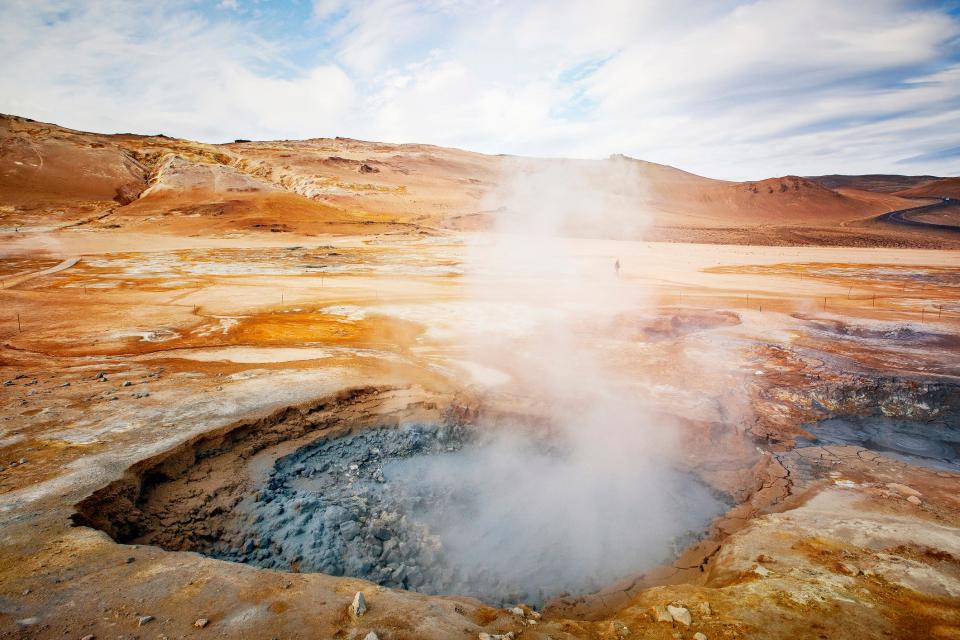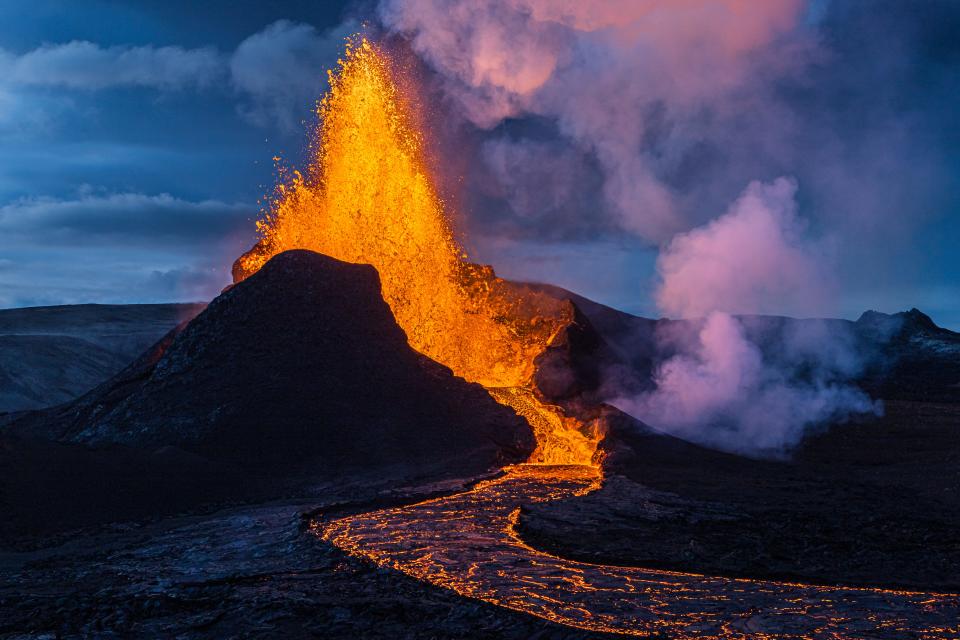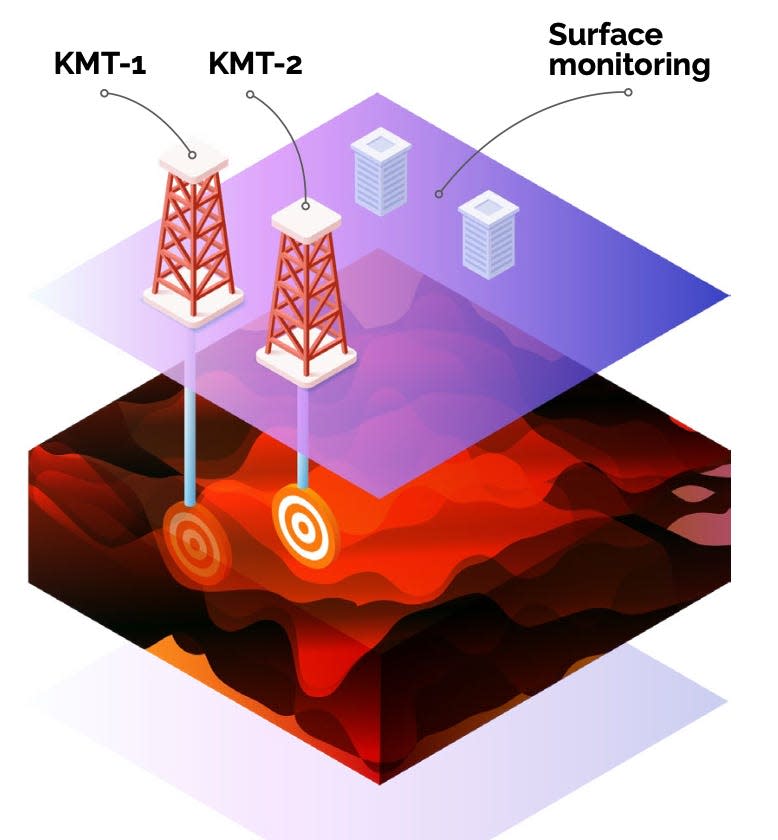-
Scientists in Iceland want to drill directly into an underground magma chamber.
-
The project could provide clues about how volcanoes work and create geothermal energy.
-
The biggest hurdles are getting financing for the project and figuring out how to drill into magma.
Scientists in Iceland want to drill a hole into a magma chamber about a mile underground in an attempt to generate unlimited energy.
The Krafla Magma Testbed (KMT) aims to create the world’s first research center above a magma chamber to monitor, sample and test the molten rock on site for the first time.
The center hopes it can provide unprecedented insights into how volcanoes work and open new avenues for limitless geothermal energy.
“Magma in the Earth is the last undiscovered frontier,” Hjalti Páll Ingólfsson of KMT told Business Insider.


An accidental discovery
Research into magma chambers is crucial. These pools of molten rock, located in the Earth’s crust, can create volcanoes if they find a way to reach the surface.
But they are incredibly difficult to locate with surface equipment and difficult to track in the run-up to an eruption.
“We have no direct knowledge of what magma chambers look like, which is of course crucial for understanding volcanoes,” Paolo Papale of Italy’s National Institute of Geophysics and Volcanology in Pisa, who has written on the subject, told New Scientist.
In 2009, scientists identified a potential candidate about 4 miles underground near the Krafla in northern Iceland. So they started drilling.
But about a mile into their descent, their drill got stuck. Only later, when it resurfaced with shards of volcanic glass, did they realize what had happened. They had accidentally stuck their heads in a magma chamber.
The scientists managed to take a few measurements, but eventually the wellhead became too hot to function, according to New Scientist.
They decided to pour cold water into the well to cool it, which released black, billowing clouds that destroyed their rigging.
Now, fifteen years later, KMT wants to drill into the room again – but this time it wants to be able to stay, with the help of a few clever technical tricks.
Reaching the magma with a glassy stone ‘sock’
Krafla is a perfect location for these kinds of experiments. The magma there is old and gloomy, meaning it’s unlikely to cause an eruption or flow out of the well if you experiment with it, Ingólfsson said.
Because it is so close to a volcano, small tremors caused by the scientists entering the chamber are unlikely to have an impact, Jon Gluyas, professor of earth sciences at the University of Durham, told BI.
“If you’re in Iceland, you’re already in an extremely active volcanic area. There’s nothing people can do that will materially change that one way or another,” Gluyas said.
However, standard oil rigs cannot survive under these conditions.
“It’s scorching hot. And that means the materials you’re going to use when drilling aren’t suitable for those kinds of temperatures,” Gluyas said.
A major challenge, Ingólfsson said, is drilling directly into the magma while protecting the equipment.
The solution is quite simple: freeze the solid magma. Using water, the team tries to freeze the magma in front of the drill. This creates a “sock or pocket” of frozen glassy rock, similar to the obsidian found on Earth, according to Ingólfsson.


Once that’s large enough, the drill can be removed, creating a small cavity in the chamber into which some monitoring equipment can be placed before the glass sock collapses, Ingólfsson said.
This should allow scientists to get an exact temperature reading from the inside of the magma chamber, which has never been done before, according to New Scientist.
“Will it work? That’s definitely a challenge,” Ingólfsson said.
“We think we have the equipment, we have the solutions, but it’s very difficult to test those or get them accurate unless you do it in a real environment,” he said.
Another problem will be maintaining rigging, a crucial issue as KMT wants the boreholes to remain open. The pipes that line the hole experience extremely high temperatures, as well as acidic environments that can eat away at the metal.
“We’re working on selecting the right materials and figuring out the best way to design these things so they fit and survive,” says Ingólfsson.
We know very little about the insides of volcanoes
If successful, KMT could provide a whole host of new insights into volcanic activity, Gluyas said.
“From a scientific perspective, being able to sample an active magma chamber would give you a lot of information that is normally excruciatingly difficult to obtain,” said Gluyas, president of the Global Geothermal Energy Advancement Association.
After all, most of what we know about volcanoes is what we see on the surface.


But by the time molten rock turns into lava, it has lost much of the gas that pushed it to the surface, so we know very little about the composition of magma before it erupts.
“I sometimes offend some scientists when I say that basically everything we know about the inside of a volcano is some kind of guess – an educated guess, of course,” says Ingólfsson.
By directly sampling and monitoring the magma, crucial information can be gained about its composition, and we can hopefully find ways to track its path underground. The glassy rock that formed when the magma froze could also be a goldmine of evidence, according to Gluyas, because it could contain bubbles that encapsulate the precious magmatic gases.
“There will be a lot of basic science coming out of this and there will be unexpected bonuses, but there is a practical part of this, which is a better understanding of the way the Earth behaves and therefore better preparedness for possible natural disasters,” he said . Gluyas.
KMT plans to drill a second hole for geothermal research.


Ingólfsson expects that one well in a magma chamber could be as productive as ten other wells elsewhere.
Not only is it very hot there, but the magma also changes the composition of the rock, which could make geothermal energy harvesting more efficient, according to KMT.
“The source of geothermal energy is always the magma and getting closer to magma obviously means higher efficiency,” says Ingólfsson.
According to him, their research could yield new ways to collect geothermal energy.
“You have the entire Atlantic ridge off the coast. If we combine what we learn in Krafla and what we know about offshore drilling, then you could foresee, at least as a science fiction vision, that you could harness it for abundant or endless energy of the earth,” he said.


For Gluyas, the technology could be promising, but he questioned whether it is necessary at this time.
“If you go anywhere where there is a well-developed volcanic province, Mexico, Kenya, Ethiopia, Italy, the geothermal energy is massively underutilized. I’m not sure how much more efficient systems would be if they were drilled into a magma chamber,” he said .
A short time to make a lot of money
KMT hopes to drill the first hole in the magma chamber in 2026. But there is still a long way to go.
The biggest challenge is raising money to build the research center and drill the holes. Ingólfsson estimates that KMT will need to raise more than $100 million from government organizations and industry partners.
“We sometimes say that geology has always set up the wrong poker table,” says Ingólfsson.
“In space research you build telescopes, just like for gamma rays, which cost billions of dollars. But in geology, two or 300 million are very expensive,” he said.
But Ingólfsson is confident.
“The chances of us achieving something big are very high, in our opinion,” he said.
Read the original article on Business Insider